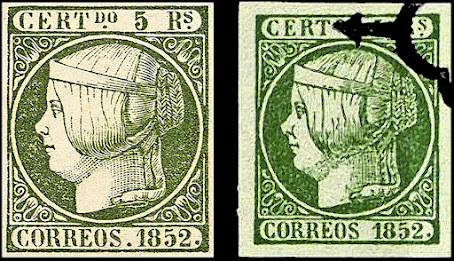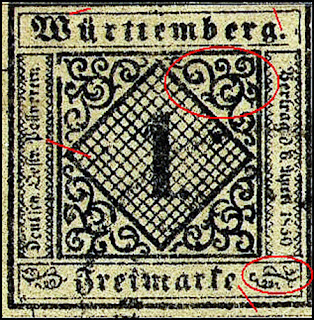The London Philatelist for August 1893, points out that “differences in the position of the period after ‘Postverein’ may be found in all values except the 18kr. There
are three types in all. In Type I the period is between the second and third points of the zigzag lines of the border; in type II it is exactly over the second point; and in
type III it is exactly above the third point. All three types are found on the 3 kreuzer, types I and II are found in the 1, 6 and 9 kreuzer, while the 18kr is known only with
the first type.
Genuine Mi 1
1. 2 dots above the u
2. The two “r’s” in “Wurttemberg” in the upper inscription band have no spur.
3. The right ornament of the two ornaments to the right and left of the upper tip of the square, is somewhat higher than the left.
4. The final dot of the “g” in “Wurttemberg” is very near to the upper part of this letter. And is diamond shaped.
5. & 6. Dots are square shaped.
7. The upper spur of the “k” in “Freimarke” is very long.
8. In the 1 Kreuzer value the second background line of the center piece in the third square is interrupted.
9. Thirty-two tips of the zigzag lines in the side label may be counted.
10. The serif of the “1” is long and curved.
11. Note the position of the dot in the 2nd square from the left. Different for other values.
3 Types
Type I
Point behind "Postverein" just above the second peak of the underlying jagged line.
In the upper font box, the lower horizontal left and right slightly bent down.
Type II
Point behind "Postverein" between second and third top.
In the lower font box, the two verticals have significant gaps.
Type III
(Most frequent of the year of publication 1853 · 58 with almost only black cancellation.) Point behind "Postverein" between second and third tip.
In the upper text box, the left vertical is usually bulged outward, the lower horizontal thickens to the left.
Forgeries
There does not appear to be many forgeries of the M1. Billigs only notes 2.
“W” touching upper frame.
Round dot instead of a square one
Thick lines in all corner designs.
Corner branch & grapes reversed
Narrow section of squares.
The serif of the “1” is not curved.
A decent forgery that sold on eBay in 2016 for $75 with several bidders.
The first sign of forgery should have been the guide lines around
No dot after Freimarke or 1850
The serif on the 1 curves the wrong way
A modern Peter Winter forgery. Excellent with only a few issues
The serif of the “1” is not curved. The dot after the last word top left is too close
The last “e” at the bottom is not shaped properly
Mi 2 Types
 |
| Type I |
 |
| Type II |
 |
| Type IVa |
 |
| Type IVc |
 |
Type V
|
ForgeriesPeter Winter forgery of probably a 2d
The honeycomb background has too many breaks and the shapes are inconsistent
Mi 3
6 Kr yellow green on very thin paper.
Same genuine characteristics as before.
The break shown is fairly consistent.
Types
Type I Point behind "Postverein" over 2 top.
The inner serrated line of the right font is broken below the 1 of "April"
Type II Point behind "Postverein" between 2 and 3 points.
The lower horizontal in the upper font thickened in its course to the right.
Type III (Most frequent of the circulation years 1853-58 with almost only black cancellations.) Point behind "Postverein" between 2 and 3 top. In the upper font box, the left vertical is usually bulged outward, the lower horizontal thickens in its course to the left.
Forgeries
This is a well executed forgery, possibly a Sperati?
1. Odd shaped ‘t”
2. Letters not aligned
3. Dot in triangle
4. “F” touches the frame line
5. Frame lime is wandering and not a single unit
Peter Winter forgery with many broken and incomplete lines
Mi 4
 |
| Mi 5 Type II |
All the previous characteristics apply
Forgeries
Many broken or missing lines, Shapes around the numeral are inconsistent.
Mi 5
This stamp has many forgeries
18 Kr Mi 5 Type II (The line under “Wurttemberg” tapers from left to right)
1. The ornament on the right of the upper tip of the central square is smaller than the ornament to the left of the tip.
2. In the upper part of the “8” there are 9 visible hatch lines, the last one (10 ) at the top is usually faded.
3. The lower part of the “8” has eleven shading lines.
4. In the lower inscription label , the upper end line of the ornament, consisting of grapes, is broken.
5. The end of the lower runner carries on into the main stem.
6 . The period behind ” Freimarke” & “Wurttemburg” is diamond-shaped.
7 . At the top of the “k” in ” Freimarke” there is a long spur.
8. The zigzag lines in the side labels have thirty-two tips.
9. The up-stroke of the figure 1 is long and curved.
The horizontal lines surrounding the value are 25 in number.
Forgeries
Sperati forgery, with a few tell tale errors.
Many broken lines inside the “8”
The frame on the right has an irregular area
There is a notch in the bottom right frame
The top left corner frame has a break
Both of these the serif on the “1” is too short and not curved
Letters like the “b” and the “F” touch the frame
On the left, the bottom left ornament is too far from the frame line
The small lettering on the right one is blotchy

Peter Winter forgery on cover
Fake Cancels
‘* CANNSTATT 15 JUN 99 * in a single circle
‘OKT 13 10-11 V M.NECKAR F’ part of a circular cancel
‘STUTTGART 21 NOV 11-12 1861’ in a double circle
‘KIRCHHEIM 9 OKT 13’ part of a circular cancel
‘TUTTGART Nr1 17 KT 3’ part of a circular cancel
‘NIJAGST’ part of a circular cancel
‘TUTTLINGEN 2 APR 1867 3 N 6’ circular cancel (two rings outside and one inner circle)
‘STUTTGART 12 4 (1) ‘ in a single circle
Reprints
The catalog value of genuine unused stamps is much higher than used ones.
Aside from the forgeries which are generally distinguishable, the reprints pose the biggest issue to collectors.
There are three types of reprints:
Official Sept. 1864, smooth paper; thin gumming;
Official 1865, 1 Kr smooth paper, 3-9 Kr Rough paper. Without gum
Official 1865, numerous, various color paper. Gummed and ungummed paper. 102 different known. As these reprints were printed singly, the margins are much
wider than in the previous reprints.
The center piece of the reprints is that of the original.
The frame lines were produced anew along with the inscriptions by a single die. This is where you can note the differences.
Characteristics of reprints
The two “r’s” in “Wurttemberg” have a small spur.
The “b” in “Wurttemberg” is shorter than in the original.
The distance of the ending dot of the “g” in “Wurttemberg,” from the top of that letter, is slightly bigger than in the original.
The spur of the “k” in “Freimarke” is short.
The grape-like ornament at the bottom right does not contact the frame line.
The period after “Freimarke” is round.
The zigzag lines on the sides have twenty-nine tips.
The distance of the “W” of “Wurttemberg” from the frame line is 1.5 mm. (in the original 1 mm.)
Examples
1865 reprint in one of many colors
Bibliography
The Serrane Guide to Stamp Forgeries
H. Bynof-Smith: Forged Postage Stamps of Europe and Colonieis
Album Weeds – How to Detect Forged Stamps, R.B. Earée: 3rd Edition
650 falsche stempel und Prufzeichen BDph
German Philatelic Society Reference Manual of Forgeries
Fritz Billig: Großes Handbuch der Fälschungen, WÜRTTEMBERG 1935
Distinguishing Characteristics of Classic Stamps: Old German States, Hermann Schloss
German.Empire.Stamps. Poole
Germany Specialized.1849.1945.Michel
Germany States Vol 3, Muller, 1933
The Forged Stamps of All Countries, Dorn, J.
Altdeutschland spezial-katalog und handbuch, Grobe 1963
Handbuch der Postfreimarkenkunde Altdeutsche Staaten, Krötzsch
Altdeutschland – Württemberg/ Allgemein: 1952
Handbuch Der Neudrucke , Paul Ohrt, 1938.
Handbok för filatelister Sigurd Tullberg.
Étude sur les Faux Timbres d’Europe, A. de Haene
Handbuch der Wurttemberg-philatelie : kreuzerzeit 1851-1875









.jpg)
.jpg)
.jpg)




























.traits.jpg)






























